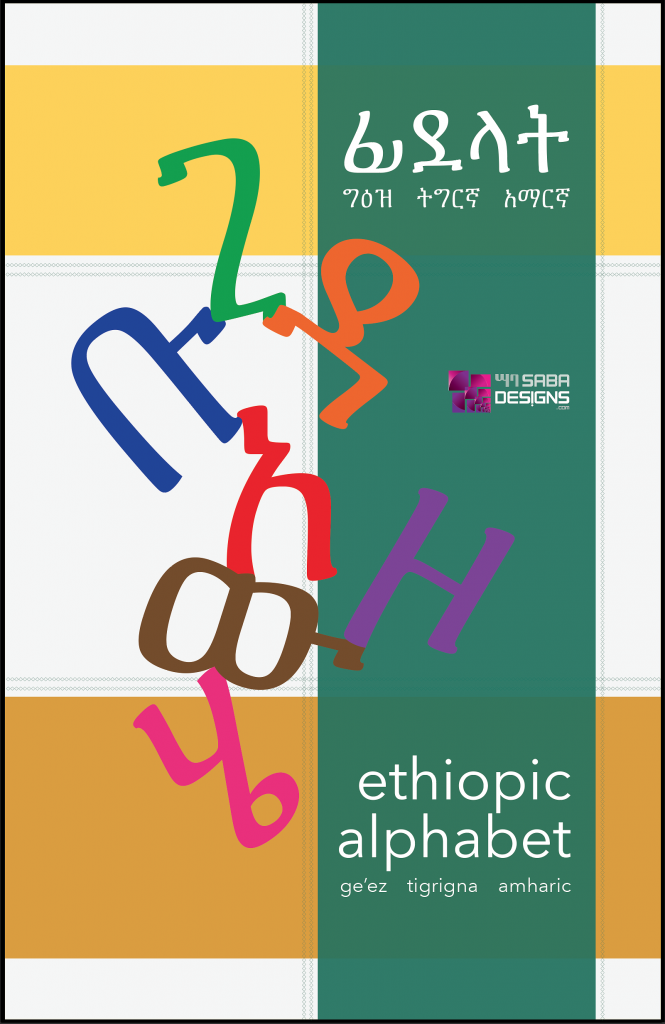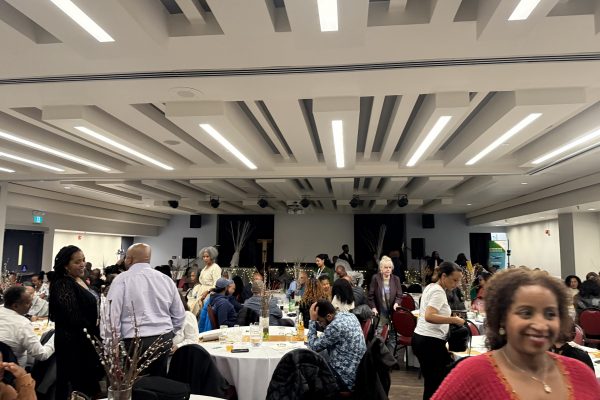A major entertainment event in Toronto, you would have seen Saba Alemayehu leading Nouvel xpose Dance Troupe introducing Ethiopian and other African dance moves.
Now a mother of two, Saba found the inspiration to design a new book . “Ethiopic Alphabets” “ፊደላት”. The book makes it easy for kids to learn Ethiopian alphabets. I interviewed Saba about her books for ethiofidel.com .
Tell us about your new book. What is so unique?
Thanks Johnny for giving me space to introduce your audience to my new book “Ethiopic Alphabets : ፊደላት”. The alphabets are not mine, of course. They’re the legacy of a couple thousand years of scriptures in the Ge’ez, Tigrigna, Amharic, and other languages of Ethiopia. I just found a way to help make it easier to memorize the alphabets and learn to read. This well displayed and organized system makes it easy to recognize and remember the letters by helping the reader create a color pattern memory. It also has Latin phonetics for those with a different language background. It’s especially great for kids’ sense of play and fun.

2 How did the idea come about the book?
My daughter was a late-talker so to teach her Amharic along with the English she needs to navigate Canada was difficult. However, we noticed early on that she’s very visual and finds it easier to learn that way. So I thought perhaps it’d help her to know the alphabets and learn to read early with the hopes that she would have more means of communicating and learning. To make that possible for English was simple as there are so many resources: books, toys, shows, etc.
However, for Amharic, putting up a black and white chart and having her chant it over and over seemed a long and numbing way to get it done. This was the way I learnt it as a kid and let’s just say I couldn’t wait to go outside instead. So it seemed better to try to use her love of colors and patterns and thus the idea was born.
3 Who were you thinking of when you designed this book? Who are your ideal targets?
The book is basically for anyone who wants to get started on learning to read Amharic, Tigrigna or Ge’ez languanges. And specifically, it’s for diaspora Ethiopian kids who may find the regular alphabet chart quite overwhelming and daunting to work with. This breaks it up into digestible pages to help them focus on each set with color patterns. The latin phonetics are also great for those who are from an English speaking background as most diaspora Ethiopian kids are.
4 How was the feedback so far? Any examples?
Well, as I’ve been using this system at home for a while, the feedback from my kids has been great. They love learning in this way and my older one has memorized them better than me now. It’s helping them examine each letter more closely to make it easier for them to read and write.
As for everyone else, I don’t know yet as it’s brand new to the public and I haven’t really promoted it to get the word out yet. So thanks again for this feature to let people know. I hope to hear from more readers as time goes on.
5 How do you connect language acquisition and culture for children born and grown up outside of their parent’s home countries?
Language carries so much information about the culture, history, spirituality and temperament of a people. It also influences each individual’s personality. I think for diaspora kids, being able to speak their parents’ mother tongue will help them understand their parents as well as themselves and their ancestral past. And learning languages in general, I think, is crucial in helping kids develop the flexible and creative mindset to navigate this diverse world.
6 Any recommendations for parents who want their kids to learn the Amharic/Tigrigna /Geez alphabets?
Memorizing a chart may not be every kid’s interest or strength so try to find ways to make it interesting and fun. Try making games and activities out of it – tracing, coloring, crafting, playdough, or even trying to act out the letters with their bodies etc. You can also focus on just one or two sets at a time. Or focus on ones that have things in common together and try to understand what makes them different; for example, በ, ሰ, ሸ, ቨ or የ, ደ, ጀ etc. Also helpful is practice reading and writing, especially on topics they are interested in. And finally, there’s the good old chant, of course: ሀ ሁ ሂ ሃ ሄ ህ ሆ••• አ ቡ ጊ ዳ ሄ ው ዞ!
7 Tell us about yourself. We have known you as the choreographer and dancer in Novel Exposé Dance troupe introducing Ethiopian culture. Is this book an extension of that effort?
Yes many in the community may know me as a dancer, instructor, choreographer. I’ve since become a mom of couple of very curious firecrackers. I’d also recently produced the movie Two Ways To Heaven with my husband, Dawit of TereTereT Productions (available on YouTube as a series at http://TwoWaysToHeaven.TereTereT.com). I’ve also been doing graphic and web design for various artists, festivals and small businesses in the community. I love exploring the depths of life in many different means and with every endeavour is an opportunity for connection: with the past, present and the people around me. This book “Ethiopic Alphabets : ፊደላት” was a means of connection with my kidsies and I hope it can be so for many families.
9 Where can we get this book?
“Ethiopic Alphabets : ፊደላት” is currently available worldwide online both as digital and hardcopy book on Amazon.
– Here’s the short link http://Books.SabaDesigns.com
– Or search “Ethiopic Alphabets” at the Amazon site of your country
Thanks for staying with me this far. I hope to hear from any of you who may become my readers. Much love!
Thank you Saba













